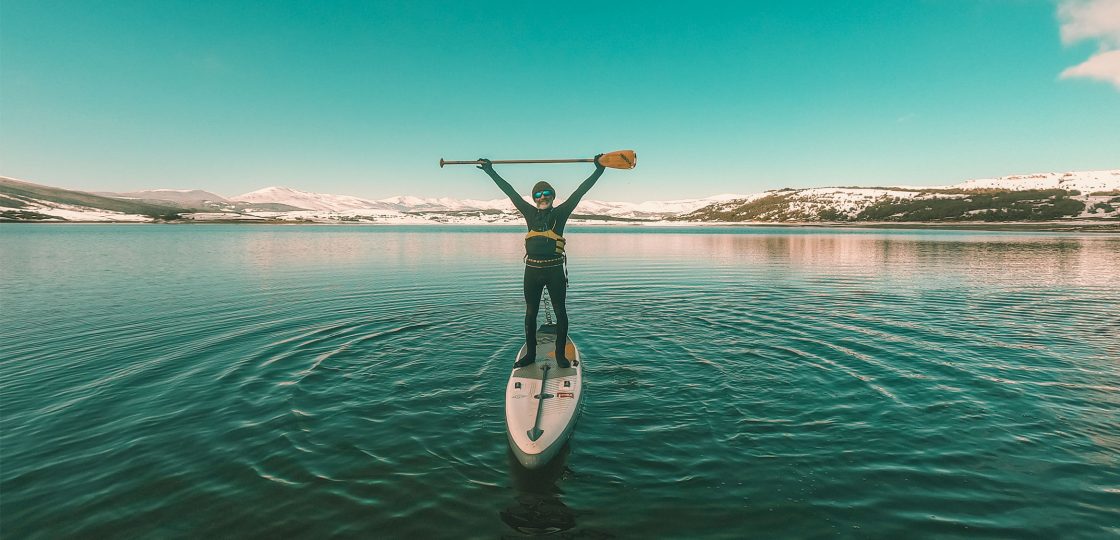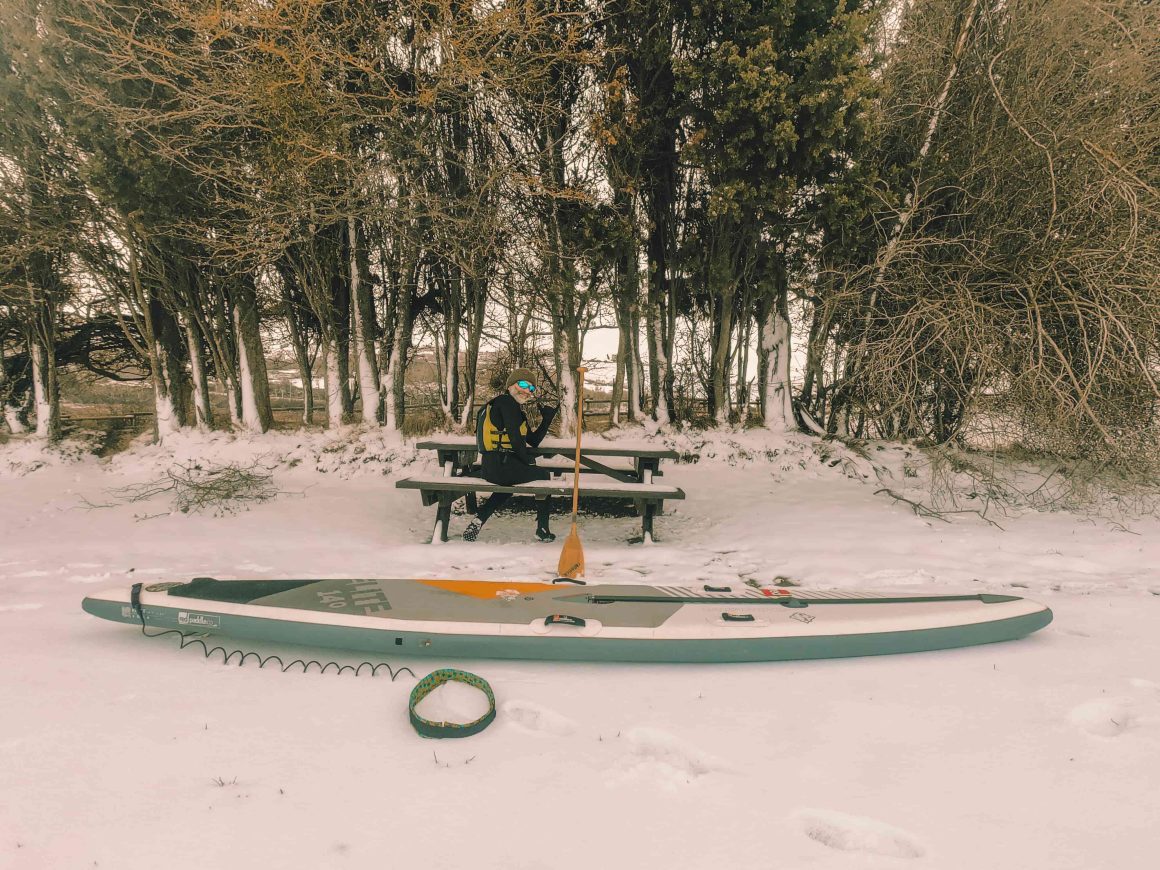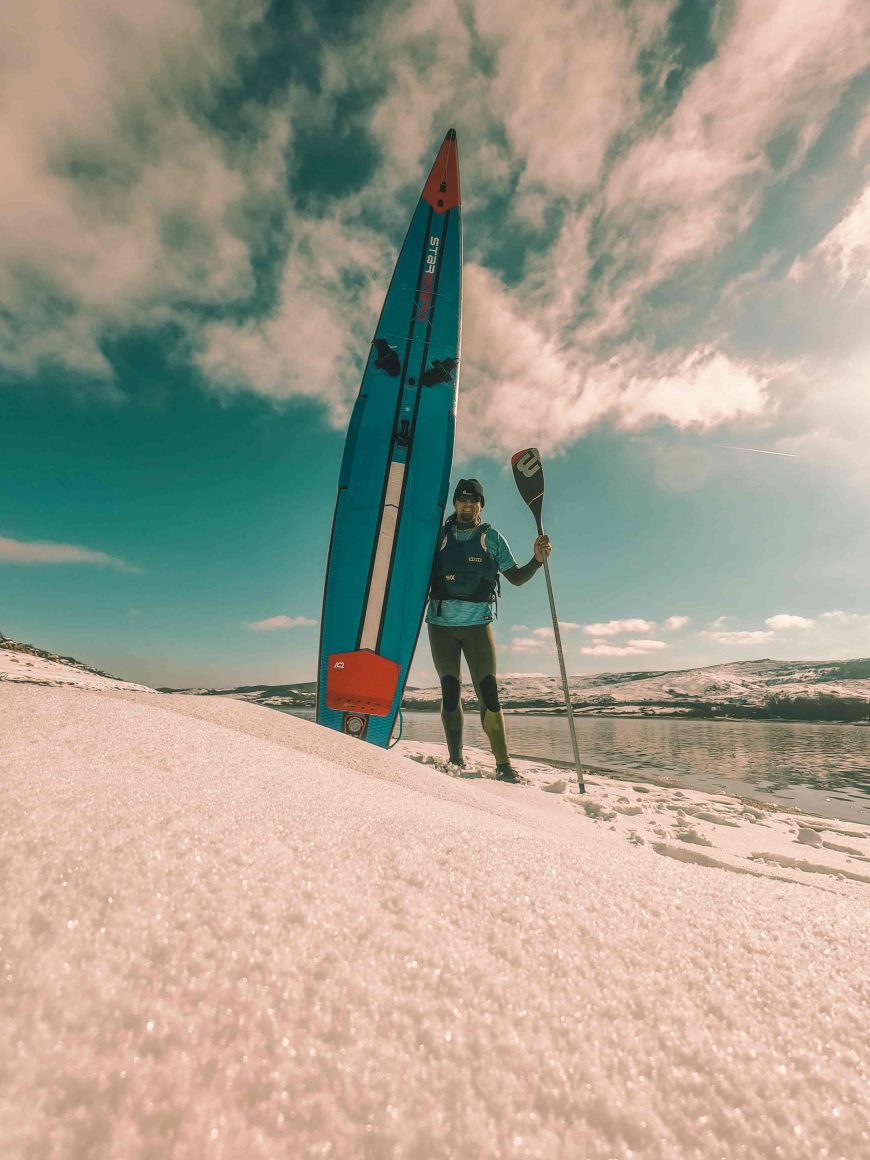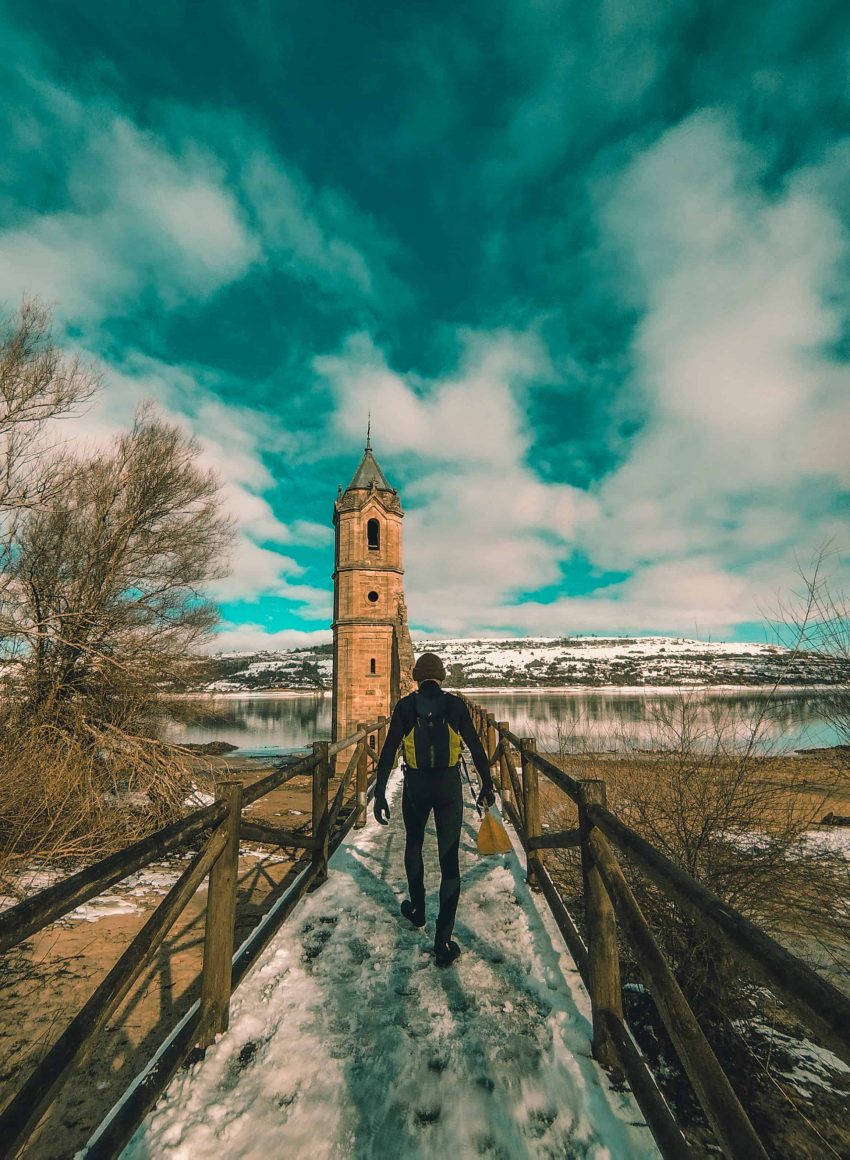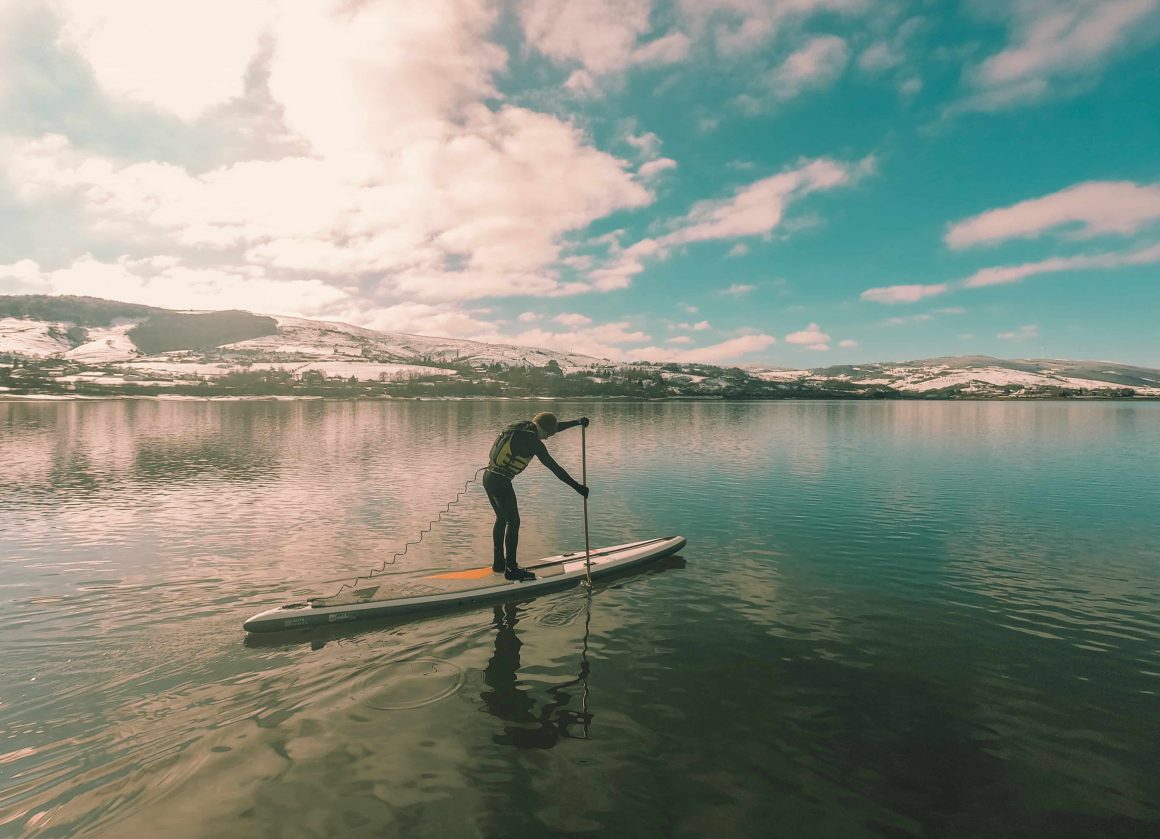Our partner Chore Waterman offers you a few tips for your Stand Up Paddle routes in winter time. Explore in the snow with your SUP board!
The snow white, that sky so blue…there is silence and peace!
The theory tells us that water sports are done in warm places, but we are attracted to the extreme, the different, the complicated, and such an simple activity can turn into a nightmare if we do not take several issues into account, and that is that we always I say it:
“Remember that the human being, when he is in the water, is in a hostile environment.”
The simplest example: a simple faint while walking down the street is a scare; If that happens to you in the water, it is more than likely a drowning.
Behind these wonderful photos there are almost 2 weeks of work, which I will try to summarize in the best possible way on these pages:
PLACE
Check if it is possible or not, if there are restrictions (dates, times) and/or if you need permits. On the pages of the different hydrographic basins you will find all the necessary information or, in case of doubt, ask your corresponding federation (Surfing/Canoeing) or Clubs/Schools in the area.
– Entry/exit points. Always look for more than one, taking into account possible emergencies and the distance that you are going to navigate, according to your level, and taking into account the conditions of the moment (wind etc…). Google Maps is a good tool.
WEATHER
Está claro que tiene que hacer frío si o si (entre -2 y +4ºC), pero vamos a intentar pasar el mínimo, lo justo, así que es muy importante lo siguiente:
It is clear that it has to be cold yes or yes (between -2 and +4ºC), but we are going to try to keep it to a minimum, just enough, so the following is very important:
Clouds + wind: even if it’s 2 or 4 knots, the wind at that temperature can leave you freezing. Under these conditions, I would discard the output.
Sun + wind: You will notice that the sun heats up, but the air at that temperature is freezing. In areas such as the face or hands, if you do not cover them correctly, you will have a hard time in the cold. Not to mention if you have wet feet…
Clouds without wind: It seems to me a better option than the previous one, as long as you go correctly equipped in terms of clothing. In addition, in these conditions, the option of paddling while snowing could be given.
Sun without wind: it is the ideal condition, believe me when I tell you that you are going to get hot. As long as you don’t fall into the water, of course.
Check Windguru, if Kite or Windsurfing is done in the area it should appear, or any other similar page. You can also search for webcams, if the site is frequented or there is a nearby population, it is easy to find one.
CLOTHING AND EQUIPMENT
It will be cold: as I mentioned before, between -2 and 4ºC, so we are going to cover all parts of the body. Always thinking that we are going for a crossing, or a race, or a DownWind, or to jump into the water.
Body: The ideal would be a DRY SUIT. They are completely waterproof suits, in the event of a fall no water enters. They are light and are prepared to be able to wear only thermal clothing underneath. This way you could take warm and comfortable crossing, but unfortunately these suits are made to measure so that they work correctly, due to the measurements of the wrists, ankles and neck, and they are not accessible to any economy, they cost between 500 and 1000 euros. So we’re going to resort to snow gear, if you heard right, or a wetsuit. In the photos I am wearing a high-end 3/2mm, but I recommend a 4/3mm.
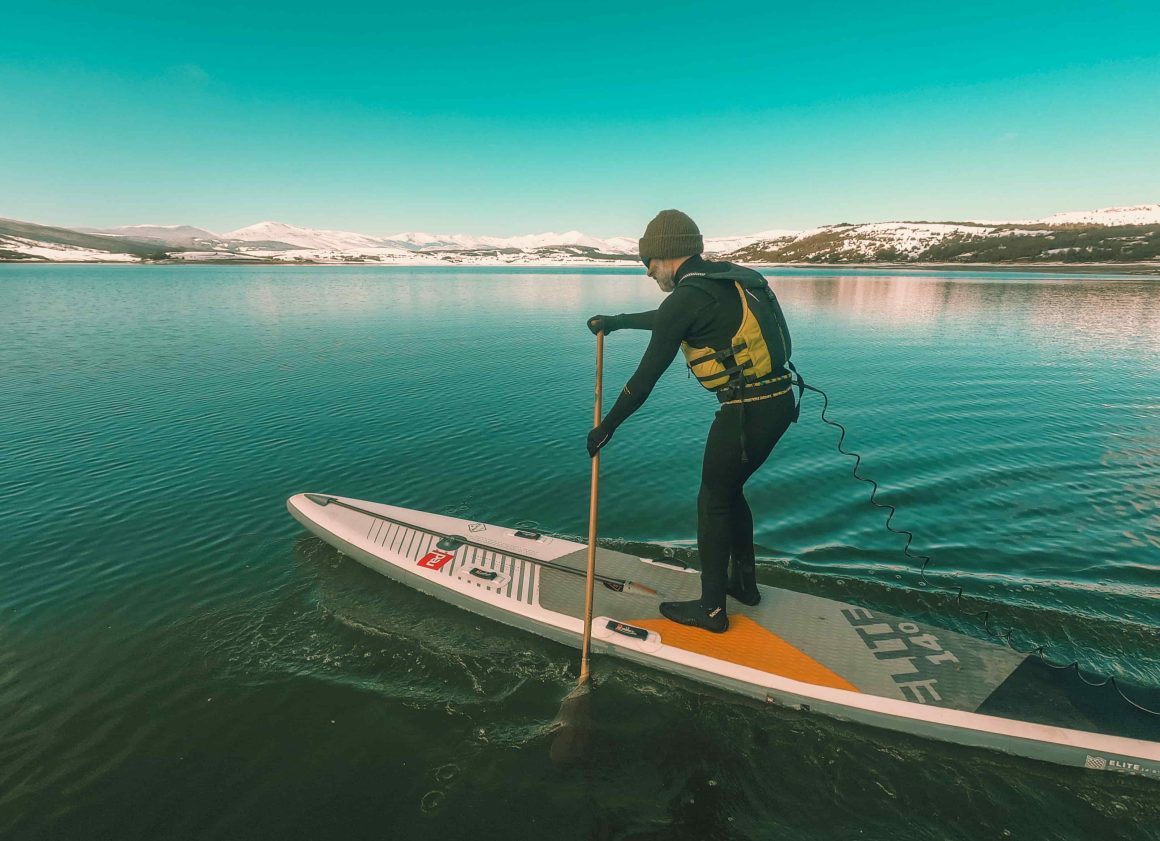
To differentiate if there are doubts between one outfit or another, I would take neoprene if you go with a race board, there is some possibility of falling into the water and you want to be more comfortable to paddle fast. And the snow clothes to go on the AllRound board and you are sure that you will not fall into the water.
Pay attention to detail, both Nico and I wear an APPROVED LIFE JACKET! That it is MANDATORY IN RIVERS AND RESERVOIRS and, out of common sense, it will make you submerge less in the event of a fall, and therefore you will get less wet, very important!
Extremities: this is something that those of us who surf have taken many years to learn. And it is that we have been putting millimetres and millimetres in the body without sheltering the extremities. Our feet, hands and head are very important. The last, represents almost 10% of our body surface, so a good wool hat and rowing, and if you can cover the neck much better.
Of course, gloves too. Whether they are neoprene or street/snow, the most important thing for me is NOT TOUCHING THE WATER WITH YOUR HANDS.
If the previous points are essential, I leave the most important for last…THE FEET.
The water will be between 0 and 5ºC maximum, so the ideal would be NOT TO WET YOUR FEET. In addition, it is an area that will be static while we paddle, so they will not get hot. The neoprene is the first thing that comes to mind, but remember that it ends up getting soaked, either when entering/exiting the water (to try to avoid it, look for a jetty or ramp for this operation), or due to splashes when paddling.
In my case I wear 2 pairs of booties. Between them they add up to 8mm, one on top of the other, some 3mm Bodyboard (without sole or velcro) and on top of 5mm others with a “river” type sole. These last ones are thicker (of course, 1 or 2 sizes larger than my foot, so that the 3mm pair fits comfortably under them), but the ideal would be a high waterproof boot with good wool or thermal socks underneath.
Apart from all this, common sense. Carry a mobile phone with a case, a whistle, an energy bar or a chocolate bar, and hydration. If you plan to spend a long time paddling, always be accompanied and that someone knows where you are going, what time you enter and the approximate time you leave the water (and notify that person when leaving, of course) are just a few small tips that can become fundamental tools on our route.
About the board. I recommend inflatables, since they are higher than the rigid ones from Race or AlRound, and unless you are going to a competition, a stable board. This way you will get your feet less wet and you will run less risk of falling into the water.
Another thing about the inflatables is that the swelling will make you warm in the water hehe.
As for the paddle, no difference compared to the one you take on the beach. The only thing that you will find is the harder water, the paddling will cost you a little more (and in the altitude, less oxygen).
POST ROUTE
I think it is very important to leave everything well prepared for when you get out of the water. Dry clothes (and even spare, in case you have wet the socks you were wearing, for example) and other belongings (a poncho helps a lot), to pick up as quickly as possible, spend less time outdoors and warm up as soon as possible, especially if by bad luck you have fallen into the water.
An insulated bottle with a hot drink/broth is a very good idea, as well as going to a nearby place to regain strength with a typical food menu of the area and dates, bone, stew and stews, which the locals eat for a reason.
Enjoy the place, landscape, sky, silence, peace…pay attention to not to trip over rocks/branches and fall, respect the fauna and flora and leave the place as clean, or cleaner, than you found it.
